Explore practical dialogues for tourists in Italian, covering phrases like "mappa" (map), "biglietto" (ticket), and "ristorante tipico" (typical restaurant), to confidently ask for tourist information, buy public transport tickets, and get directions.
Listening and reading
Start this class by listening to the audio and completing the corresponding exercises.
Vocabulary (15) Share Copied!
Exercises Share Copied!
These exercises can be done together during conversation lessons or as homework.
Exercise 1: Translate and use in a sentence
Instruction: Pick a word, translated and use the word in a sentence or dialogue.
1
L'entrata della metro
The entrance to the underground
2
Decidere
To decide
3
La chiesa
The church
4
La strada pedonale
The pedestrian street
5
Prendere un taxi
Take a taxi
Esercizio 2: Conversation exercise
Istruzione:
- Descrivi cosa sta facendo questo turista a Copenaghen nelle immagini. (Describe what this tourist in Copenhagen is doing in the pictures.)
- Cosa potrebbe dire la persona in una qualsiasi delle situazioni? (What could the person say in any of the situations?)
- Mandi ancora cartoline dalle tue vacanze? A chi le mandi? (Do you still send postcards from your holidays? To whom do you send them?)
Teaching guidelines +/- 10 minutes
Example phrases:
|
La donna prende un taxi. The woman takes a taxi. |
|
Ho cercato le indicazioni sulla mappa. I looked up the directions on the map. |
|
Puoi dirmi come arrivare al monumento? Can you tell me how to get to the monument? |
|
Hai uno sconto per studenti? Do you have a student discount? |
|
Uso il mio telefono per arrivare al museo. I use my phone to navigate to the museum. |
|
Puoi farmi una foto? Can you take a picture of me? |
|
Devo mandare una cartolina alla mia famiglia. I have to send a postcard to my family. |
| ... |
Exercise 3: Dialogue Cards
Instruction: Select a situation and practice the conversation with your teacher or fellow students.
Exercise 4: Multiple Choice
Instruction: Choose the correct solution
1. Ho deciso di visitare il centro storico perché __ __ sentito parlare molto bene.
(I decided to visit the historic center because __ __ heard a lot of good things about it.)2. Ieri __ __ deciso di fare una visita guidata per conoscere meglio il museo nazionale.
(Yesterday __ __ decided to take a guided tour to better know the national museum.)3. Abbiamo preso un taxi perché __ __ bisogno per arrivare alla chiesa.
(We took a taxi because __ __ needed it to get to the church.)4. __ __ comprate tre cartoline per inviarle agli amici.
(__ __ bought three postcards to send to friends.)Exercise 5: A day in the city as a tourist
Instruction:
Verb Tables
Decidere - Decidere
Passato prossimo
- io ho deciso
- tu hai deciso
- lui/lei ha deciso
- noi abbiamo deciso
- voi avete deciso
- loro hanno deciso
Controllare - Controllare
Passato prossimo
- io ho controllato
- tu hai controllato
- lui/lei ha controllato
- noi abbiamo controllato
- voi avete controllato
- loro hanno controllato
Arrivare - Arrivare
Passato prossimo
- io sono arrivato/a
- tu sei arrivato/a
- lui/lei è arrivato/a
- noi siamo arrivati/e
- voi siete arrivati/e
- loro sono arrivati/e
Comprare - Comprare
Passato prossimo
- io ho comprato
- tu hai comprato
- lui/lei ha comprato
- noi abbiamo comprato
- voi avete comprato
- loro hanno comprato
Fare - Fare
Passato prossimo
- io ho fatto
- tu hai fatto
- lui/lei ha fatto
- noi abbiamo fatto
- voi avete fatto
- loro hanno fatto
Essere - Essere
Imperfetto
- io ero
- tu eri
- lui/lei era
- noi eravamo
- voi eravate
- loro erano
Exercise 6: L'uso di ne
Instruction: Fill in the correct word.
Grammar: The use of ne
Show translation Show answersne vedo, ne abbiamo, ne compro, ne voglio, ne compriamo, ne ho, non ne
Grammar Share Copied!
It's not the most exciting thing, we admit, but it’s absolutely essential (and we promise it'll pay off)!
Verb conjugation tables for this lesson Share Copied!
Decidere to decide Share Copied!
Passato prossimo
| Italian | English |
|---|---|
| (io) ho deciso | I decided |
| (tu) hai deciso | You have decided |
| (lui/lei) ha deciso | he/she has decided |
| (noi) abbiamo deciso | we decided |
| (voi) avete deciso | You have decided |
| (loro) hanno deciso | they have decided |
Don't see progress when learning on your own? Study this material with a certified teacher!
Do you want to practice Italian today? That is possible! Just contact one of our teachers today.
As a Tourist in the City: Lesson Overview
This lesson is designed for A2 level learners of Italian who want to communicate effectively when visiting an Italian city. It focuses on practical dialogues and vocabulary helpful for tourists, including asking for tourist information, buying public transport tickets, and requesting directions to restaurants.
Key Dialogue Situations
- At the Tourist Office: Practice common phrases like "Buongiorno, potrei avere una mappa della città?" (Good morning, could I have a city map?) and learn how to ask for recommendations, such as museums or tours.
- Buying Transport Tickets: Master phrases used when purchasing tickets or daily passes, for example, "Vorrei un biglietto per il tram" (I would like a tram ticket) and questions about ticket validity.
- Asking for Restaurant Directions: Learn how to inquire about local restaurants and understand directions, with expressions like "Dove si trova un buon ristorante tipico vicino?" (Where is a good traditional restaurant nearby?).
Verb Practice: Present and Past Tenses
The lesson includes multiple-choice exercises on verb conjugations in the present tense, as well as a short story using the passato prossimo and imperfetto past tenses to describe a day as a tourist. Verbs such as controllare (to check), decidere (to decide), fare (to do/make), and inviare (to send) are practiced with their correct forms.
Short Story Summary
"Una giornata da turista in città" recounts a visit to the historic center, buying a map, deciding on a guided tour, asking fellow tourists questions, taking photos, and sending postcards. This story helps learners see vocabulary and grammar in a natural, contextualized format.
Useful Vocabulary and Expressions
- Map-related: mappa (map), ufficio turistico (tourist office), indicazioni (directions)
- Transport: biglietto (ticket), tram, abbonamento giornaliero (daily pass)
- Restaurants: ristorante tipico (typical restaurant), Trattoria da Luigi, Osteria 'Bella Napoli'
- Common Verbs in Context: controllare (to check), decidere (to decide), fare (to do), inviare (to send)
Important Language Notes
Since both the instruction and learning languages are the same (Italian instructions for learning Italian), the lesson focuses entirely on Italian language usage without translation comparisons. For example, Italian verbs show clear conjugation patterns, especially in passato prossimo (present perfect) and imperfetto (imperfect) tenses, which express completed actions and ongoing past actions respectively. Phrases such as "ho comprato" (I bought) and "facevo" (I was doing) illustrate these differences well.
Some useful expressions include:
- Potrei avere... - polite way to ask for something, e.g., a map.
- Mi può consigliare... - asking for recommendations.
- Quanto dista...? - asking for distance.
- Va dritto, poi gira a sinistra... - giving directions.
This lesson equips learners with practical phrases and verb forms needed to navigate common tourist situations confidently in Italy.

























